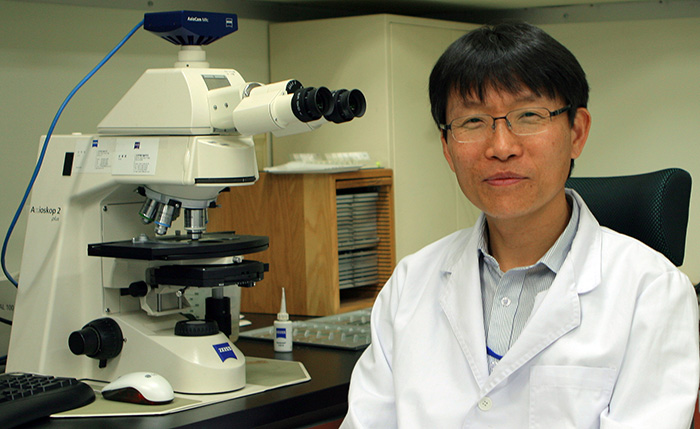View this article in another language
- 한국어
- English
- 日本語
- 中文
- العربية
- Español
- Français
- Deutsch
- Pусский
- Tiếng Việt
- Indonesian
Researchers have identified three types of mold that are used during microbial fermentation.
The scientists have succeeded in classifying three species of black and white aspergillus mold that are commonly used to break down starches and to form simple sugars while making makgeolli, a type of rice beer, and Japanese-style sochu.

“There have been reports of various black and white aspergillus since the discovery of aspergillus luchuensis in 1901, but there has not yet been a complete categorization of all species of aspergillus,” said Hong Seung-beom, a researcher at the Rural Development Administration (RDA). “Concerning the species of black and white aspergillus which we recently announced, we classified them into three major categories by analyzing their characteristics and their DNA base sequence.”

In Korea and Japan, over 10 different types of black and white aspergillus have been announced since 1910, including luchuensis, awamori, kawachii, usami, shirousamii and coreanus. However, because the announcements were made without any DNA analysis, it was not clear how they could be categorized and thus the names were not recognized as being the official scientific names. So far, Japanese, American and Dutch taxonomists and brewers have conducted much research trying to classify aspergillus, but they have not been able to come up with a unified pedigree system recognized by academics around the world. This has made it very difficult to conduct academic exchanges and joint research on aspergillus, and has stymied any quality improvement or development of the alcohols.

The RDA collected standard strains of black and white aspergillus not only from Korea but also from Japan, the U.S. and the Netherlands, and has studied their form in detail. The scientists also analyzed the mold’s DNA base sequence, such as its β-tubulin, and confirmed their taxonomic status. The research showed that they can be classified as aspergillus luchuensis, aspergillus niger and aspergillus tubingensis.
In the announcement, the RDA researchers explained that traditional Korean yeast, nuruk, is a. aspergillus tubingensis, and that kawachii, the yeast used to make makgeolli and traditional soju, and the awamori used to produce alcohol in Okinawa, are both a. luchuensis. The usami and shirousamii used to make Japanese sochu were both found to be a. niger.
“Knowing the pedigree of the aspergillus mold is going to help the development of not only Korea’s makgeolli and Japan’s sochu industries, but will also help with traditional Chinese and Southeast Asian alcohols,” Hong said. “Classification of the species is going to contribute to academic exchanges and will help when conducting joint international research. The Japanese National Research Institute of Brewing has already confirmed it will use the species of black and white aspergillus which we announced.”
By Jeon Han, Limb Jae-un
Korea.net staff writers
hanjeon@korea.kr

The scientists have succeeded in classifying three species of black and white aspergillus mold that are commonly used to break down starches and to form simple sugars while making makgeolli, a type of rice beer, and Japanese-style sochu.

Hong Seung-beam, a researcher at the RDA, heads the team that identified the aspergillus mold used in microbial fermentation. (photo courtesy of the RDA)
“There have been reports of various black and white aspergillus since the discovery of aspergillus luchuensis in 1901, but there has not yet been a complete categorization of all species of aspergillus,” said Hong Seung-beom, a researcher at the Rural Development Administration (RDA). “Concerning the species of black and white aspergillus which we recently announced, we classified them into three major categories by analyzing their characteristics and their DNA base sequence.”

A team of researchers led by Hong Seung-beom of the Rural Development Administration (RDA) has classified various black and white aspergillus molds into three types. The photographs above (from left) are the magnified views of traditional nuruk, powdered Korean yeast, aspergillus luchuensis, used in making makgeolli, and aspergillus niger. (photos courtesy of the RDA)
In Korea and Japan, over 10 different types of black and white aspergillus have been announced since 1910, including luchuensis, awamori, kawachii, usami, shirousamii and coreanus. However, because the announcements were made without any DNA analysis, it was not clear how they could be categorized and thus the names were not recognized as being the official scientific names. So far, Japanese, American and Dutch taxonomists and brewers have conducted much research trying to classify aspergillus, but they have not been able to come up with a unified pedigree system recognized by academics around the world. This has made it very difficult to conduct academic exchanges and joint research on aspergillus, and has stymied any quality improvement or development of the alcohols.

This chart shows various species of the aspergillus mold. The species of black and white aspergillus were recently announced by a team of researchers led by Hong Seung-beom at the RDA. (photo courtesy of the RDA)
The RDA collected standard strains of black and white aspergillus not only from Korea but also from Japan, the U.S. and the Netherlands, and has studied their form in detail. The scientists also analyzed the mold’s DNA base sequence, such as its β-tubulin, and confirmed their taxonomic status. The research showed that they can be classified as aspergillus luchuensis, aspergillus niger and aspergillus tubingensis.
In the announcement, the RDA researchers explained that traditional Korean yeast, nuruk, is a. aspergillus tubingensis, and that kawachii, the yeast used to make makgeolli and traditional soju, and the awamori used to produce alcohol in Okinawa, are both a. luchuensis. The usami and shirousamii used to make Japanese sochu were both found to be a. niger.
“Knowing the pedigree of the aspergillus mold is going to help the development of not only Korea’s makgeolli and Japan’s sochu industries, but will also help with traditional Chinese and Southeast Asian alcohols,” Hong said. “Classification of the species is going to contribute to academic exchanges and will help when conducting joint international research. The Japanese National Research Institute of Brewing has already confirmed it will use the species of black and white aspergillus which we announced.”
By Jeon Han, Limb Jae-un
Korea.net staff writers
hanjeon@korea.kr
